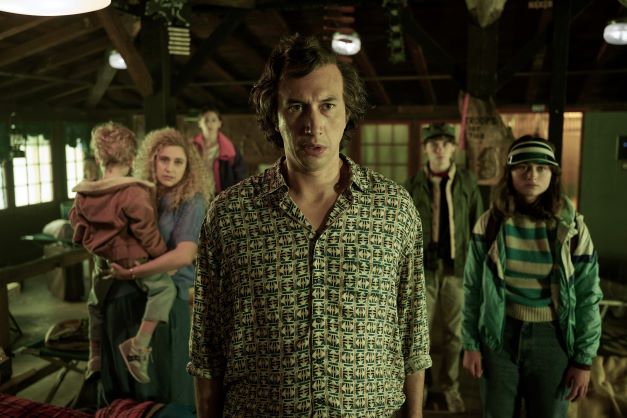
Greta Gerwig, left, Adam Driver, center, and Raffey Cassidy, right, in White Noise (Film at Lincoln Center)
In adapting Don DeLillo’s 1985 novel, Noah Baumbach has found a freedom in White Noise that pushes him to the next level. The result is an original and playful vision of impending doom, societal collapse, and the eruption of a crisis between a married suburban couple. The artistry on display is eye-catching and hard not to admire: the epic scope of Lol Crawley’s cinematography, Danny Elfman’s pumping score, the larger-than-life performances (the physical comedy of Adam Driver’s is spot-on), and a finale that I won’t describe so to allow viewers to be surprised. His newest work becomes immediately the most ambitious and riskiest enterprise of his career. After this, Baumbach won’t be the director we thought we knew so well—maybe.
White Noise is a grandiloquent dystopic vision of America (both the book and film are set in the 1980s) and an improbable comedy about the fear of death and how people find ways to avoid reminders of their ultimate fate. What in the book posed as an “alternate reality” of its present, the movie works as distorted period piece with welcomed correlations to our current times. After a couple of years dealing with a worldwide pandemic, the various demented situations portrayed onscreen won’t feel particularly exaggerated. Baumbach embraces chaos and hysteria with glee and a clear understanding that DeLillo’s doom-and-gloom warning is now our daily bread. Following the novel’s structure, the narrative is divided by three episodes that also mark changes in tone.
The first, “Waves & Radiation,” introduces Jack Gladney (Driver), his wife Babbette (Greta Gerwig), and their four children, three from the couple’s previous marriages—a model of a traditional American family living in a quiet suburb. Jack and Babbette have a healthy sex life (they read each other erotic literature, though she asks for sentences that include “enter into” to be avoided), but also have morbid conversations about who will die first. Death is a constant subject for them and a source of fear that operates as a thematic thread throughout. This is contrasted with everyday distractions (so much white noise surrounding us) that defer or avoid every memento mori.
Jack is an eminent academic in the field of Hitler studies, who demands his students to have some notions of German even if he has yet to learn the language. His colleague Murray Siskind (Don Cheadle) feels inspired by Jack’s success to explore Elvis studies, and the serious intentions of both professors are later expressed through a sort of dance-off, where the two overlap and interrupt each other speaking about Hitler’s and Elvis’s relationship with his mother, trying to outdo the other. It’s an early example of the kind of movie you are watching, a satire to a certain degree and an existentialist comedy, punctuated by extravagant events that leave no room for its characters than to evade their inner terrors, while we laugh at them (and at ourselves).
In Babbette’s case, she secretly consumes a black-market drug, Dylar, which palliates her phobia and becomes a major plot point in the third act, “Dylarama,” the chapter that almost derails the film for its clumsy attempts to reconcile the couple’s marital problems while confronting a last-minute villain. Here the storytelling takes the easy way out for Jack and Babbette to mitigate their respective addictions and fears.
The strongest and most entertaining section is the centerpiece, “The Airborne Toxic Event,” about the aftermath of toxic chemicals spillage generating a weird meteorological phenomenon that menaces the town. A big stormy cloud full of these chemicals is in motion, so Jack and his family flee to an evacuation center in spite of his initial reluctance to do so. They end up in a never-ending traffic jam worthy of Godard’s Weekend (1967), even if the sensibility is more Spielbergian (a scene where the family tries to escape the car line only to get stuck in a swamp is full of thrills and euphoric filmmaking).
White Noise is genius in parts, confusing in others. (You may get lost in the transition between the end-of-the-world scenario that suddenly dissolves to make room for a tale of confessions and acts of jealousy.) However, it is a stimulating example of giving-it-all filmmaking for art’s sake that faces a landscape where multiplexes only want tentpoles that repeat themselves while many original, offbeat offerings get lost in the streaming sea. (As a Netflix film, this seems to be the fate for this one too.) You shouldn’t miss a movie like this, and I promise you won’t become bored. White Noise might not be perfect or cohesive, but it’s restless fun and uncompromising.






Leave A Comment